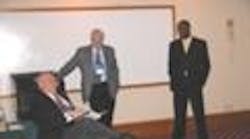Putting Several heads together to solve problems can produce results — and that was the object of roundtable discussions at the National Tank Truck Carriers (NTTC) Safety Council meeting April 1-2.
Leading the sessions were James Berryhill and Mark Berger, both of Occupational Sleep Apnea Solutions, Steve Niswander of Groendyke Transport Inc, James Simmons of the Federal Motor Carrier Safety Administration (FMCSA), and John Conley of NTTC.
Sleep apnea plagues a large part of the general population, including the truck driver community. People who do not get enough sleep have about the same reaction time as if they had a .06 alcohol level in the blood. They are more likely to be ill and more likely to be hospitalized than those who do not have the condition, Berger said.
All of this means that the driver force should be screened for the condition and those who test positive should seek treatment, Berryhill said. In addition to improving safety on the road, successful treatment can result in lower health costs and reduced liability.
Berger pointed out that updates in the FMCSA driver medical regulations will include physicians trained to recognize sleep apnea in drivers they examine. The medical examiner will be looking for symptoms of loud snoring and daytime sleepiness, as well taking into consideration a driver's body mass.
To ease driver concern about seeking help, management can set an example by having the examinations first — and those who test positive accepting treatment. In addition, drivers' families should be made aware of the symptoms.
Companies should create a fatigue management program in-house to determine who is at risk before sending drivers for physical exams. “That will rule out 70% of drivers who don't have sleep apnea,” Berger said.
Niswander noted that fatigue also can come as a result of a driver's activities when away from the job, whether for a few hours or on a vacation.
Conley said that some plaintiff attorneys are raising the issue of requiring tests for sleep apnea, and Simmons added that in some states drivers who are found at fault in fatal accidents can be charged with negligent homicide.
Rollover issues
Turning to a discussion on rollovers, Niswander and Simmons emphasized the importance of having a rollover prevention segment in driver training and reinforcing the concerns periodically. Drivers, dispatchers, and mechanics should be required to attend the sessions. Simmons said all training should be documented, including having drivers to sign in at the sessions.
Niswander added that safety directors, other managers, and dispatchers should be notified immediately when a rollover occurs so that drivers and dispatchers can be alerted about the location. In some instances where the location is deemed especially dangerous, drivers should be prohibited from taking that route.
Transportation security
The third subject receiving emphasis during the breakout sessions was transportation security. Conley discussed carriers' security plans, noting that some shippers and consignees are beginning to ask for the plans. He advised carriers to keep their plans confidential and only release a synopsis.
Part of the difficulty in the security situation is the number of federal agencies involved. As an example, the Department of Transportation and the Transportation Safety Administration are currently involved in security inspections that may include carriers.
Although Conley said the Transportation Worker Identification Credential (TWIC) program is not working smoothly, he advised carriers affected by it to continue to participate. The program goal is to ensure that any individual who has unescorted access to secure areas of port facilities and vessels has passed a background check and is not a known security threat.
He noted that some shippers and some military installations are requiring TWIC cards, as well as social security numbers, even thought the TWIC IDs are supposed to apply to maritime installations only. In addition, there are some municipalities requiring any driver who is hauling hazardous materials in their jurisdiction to have background checks, which if allowed to stand could necessitate drivers having multiple security ID cards.











